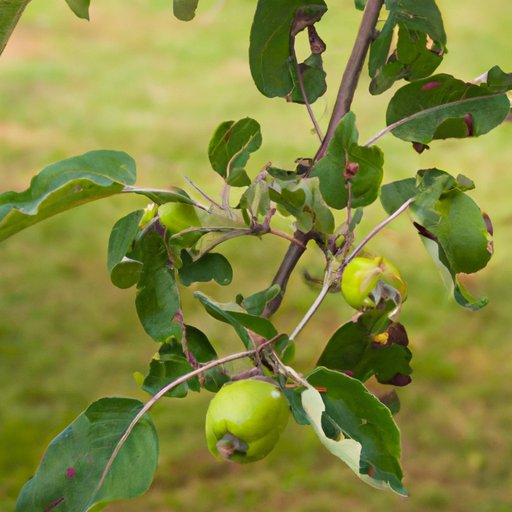
Introduction
Have you ever thought about growing your own apple tree? Not only is it a rewarding experience, but it also comes with numerous benefits. Not to mention, growing an apple tree from seed is an affordable way to start your fruit orchard. This guide will provide a complete step-by-step process that will help you grow your own apple tree from seed.
Step-by-step guide
Selecting the right type of seed
The first step to growing an apple tree from seed is to obtain the right type of seed. Choose a seed from your favorite type of apple, as this will ensure that you get the same type of fruit from the tree. You can also choose seeds from different apple types to experiment and create your unique flavor of apples.
Preparing the soil and container for planting
The soil used for planting should be composed mainly of compost, topsoil, or a mixture of both. Perlite or vermiculite can also be added for greater drainage. Your container should be at least 8 inches deep; this depth will aid the root development of the seedling. The soil should also be slightly moist before planting.
Planting the seed
Plant the seed about an inch deep in the soil. Once you’ve planted the seed, the soil should be gently tamped down. If necessary, water the soil so that it is moist but not wet. Finally, place the container in a sunny spot, near the window sill, or under a grow light. Keep the temperature between 60°F and 75°F to help the seed germinate.
Watering and fertilizing the seed
Your apple tree from seed will need to be watered at least once a week. The soil must be kept moist, but not waterlogged. After a couple of weeks, feed the tree with a balanced liquid fertilizer to promote growth.
Caring for the seed as it grows
Gently remove the seedling from the container when its size is roughly 7.5cm or when its roots start appearing at the bottom. Choose a new container that is at least 10 inches deep to promote further growth of the tree. The soil used in the new container should be a mix of compost, topsoil, and perlite. Let the seedling adjust before fertilizing again.
Transplanting the seedling into a larger container or outside
After about a year, your apple tree should be ready to be transplanted to a larger container or outdoors. Choose a site that receives enough sunshine but not too much to prevent overheating. The plant should be exposed to full sun for six hours a day. The tree should be planted in a hole twice the width of the pot, with suitable compost and topsoil mixture. The tree should be watered well and mulched a few inches away from the stem with compost or straw to retain the water.
Pruning and training the tree as it grows
The apple tree will need to be pruned to remove damaged or diseased branches throughout its growth. This will not only prevent the spread of disease but also help promote healthy growth. Once the tree has grown to the desired height, it will also need to be supported with stakes or wires to ensure it stays upright.
Harvesting the fruit
You can expect to harvest the fruits of your labor two to four years after planting your apple tree. Apples are generally ready for harvesting when they come off with a slight twist and are uniform in color. Apples on the bottom branches often ripen first. Shake the tree vigorously to dislodge apples that are ripe for harvest.
Benefits of growing your own apple tree
Growing an apple tree from seed can provide many benefits, including access to fresh and organic fruit and cost savings over purchasing from a grocery store. In addition to these personal benefits, growing your own apple tree can be environmentally friendly, as it means less transportation and packaging of your food.
Different varieties of apples
There are several cultivars of apples available, and each has different requirements and characteristics. Some of the most common varieties of apples include the Honeycrisp, Granny Smith, and Pink Lady. Each variety can be grown from seed, and careful consideration should be given to the desired taste and climate that is suitable for growing.
Tips and tricks
When planting apple seeds, it is essential to avoid over-watering, use a suitable compost mixture, and, most importantly, keep the soil warm enough. If any issues arise, such as the appearance of fungus or pests, it is essential to address these with organic methods rather than harmful pesticides. Garden gloves, pruners, and wire cutters are all necessary tools to keep the apple tree healthy and thriving.
Uses for Apples
Apples are an excellent source of fiber, vitamins, and minerals, and they can be used for cooking and baking as well as in various medicinal remedies. Commonly known for helping reduce the risk of heart disease, apples have numerous health benefits, including antioxidant properties. There’s no denying that fresh apples straight off the tree make delicious snacks.
Beginners Apple Growing Guide
For beginner apple growers, it is important to learn about the basics of growing apple trees from seed. This includes essential information on soil preparation, lighting, humidity, temperature, pruning, and more. Colleges and universities, local garden groups and bookstores may offer resources to support beginner apple growers.
Conclusion
Growing an apple tree from seed is an excellent way to produce fresh and organic fruit right in your backyard. With careful planning, preparation, and patience, you can enjoy this process and reap the benefits of having a homegrown apple tree. We encourage you to use this guide, experiment, and explore the joys of apple tree growing from seed.





